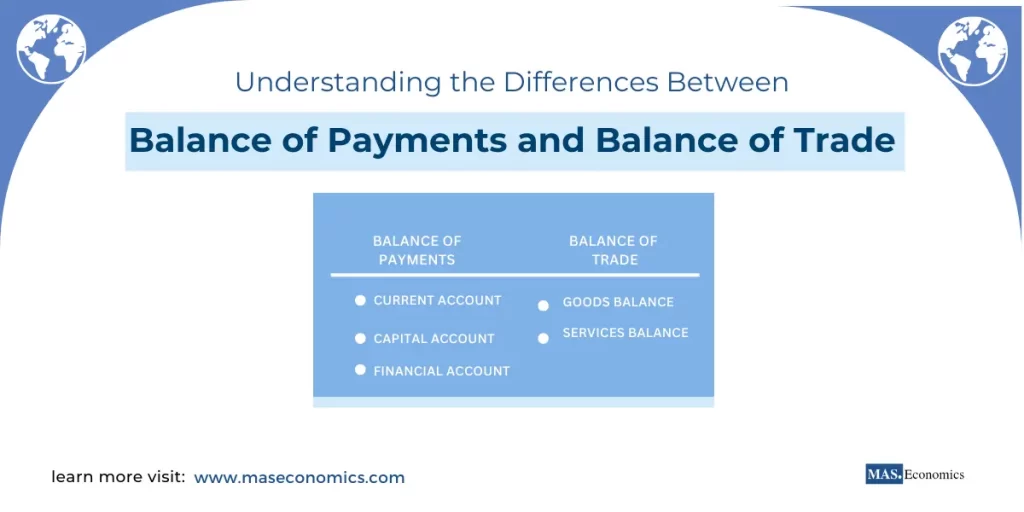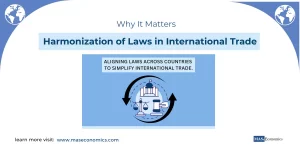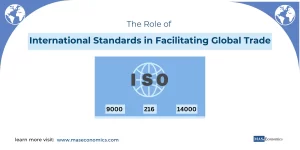Many terms in international trade and finance sound similar but have distinct meanings. The Balance of Payments (BOP) and Balance of Trade (BOT) are often confused, yet they measure different facets of a country’s economic health. While both are crucial indicators, BOP encompasses all international transactions, whereas BOT focuses specifically on exports and imports of goods and services.
Understanding the key components and differences between Balance of Payments and Balance of Trade clarifies their roles in assessing a country’s financial health. These insights help reveal the broader economic picture, illustrating how a nation’s international activities influence its economic stability
What is the Balance of Trade?
The Balance of Trade (BOT) is one of the simplest yet most fundamental measures of a country’s international commerce. It refers to the difference between the value of goods and services exported and those imported by a country over a given period. Essentially, it captures the net balance of trade activities—how much a country sells to other nations compared to how much it buys.
Components of the Balance of Trade
The Balance of Trade can be divided into two main components:
1. Goods Balance
The Goods Balance includes all tangible items, such as cars, electronics, and agricultural products. It is often called the balance of merchandise trade and reflects the physical items being exchanged across borders.
2. Services Balance
The Services Balance includes intangible items, such as banking, tourism, insurance, and intellectual property. Services are just as crucial as physical goods, especially for developed economies with strong service sectors like the United States.
Trade Surplus: When a country exports more goods and services than it imports, it has a trade surplus. This is generally viewed positively as it indicates that the country earns more foreign exchange than it spends.
Trade Deficit: Conversely, when imports exceed exports, it results in a trade deficit. This may indicate that a country is consuming more from foreign markets than it is selling, leading to potential outflows of foreign currency.
The Balance of Trade is a significant component of the current account within the broader framework of the Balance of Payments, which will be discussed in the following section.
What is the Balance of Payments?
The Balance of Payments (BOP) is a more comprehensive concept that covers all economic transactions between the residents of a country and the rest of the world during a given time frame, usually a year. Unlike the Balance of Trade, which only focuses on goods and services, the Balance of Payments accounts for all transactions, including trade, capital flows, and financial transfers.
Components of the Balance of Payments
The BOP is divided into three main accounts:
1. Current Account
The Current Account includes:
Balance of Trade (goods and services): This is where the BOT fits in as a part of the current account.
Income Flows: Income earned from foreign investments such as dividends or interest payments.
Unilateral Transfers: These include foreign aid, remittances, and other forms of one-way transactions.
2. Capital Account
The Capital Account records capital transfers and the acquisition or disposal of non-produced, non-financial assets, such as patents. Though this account is relatively smaller in most countries, it plays a vital role in balancing the books.
3. Financial Account
The Financial Account captures:
Foreign Direct Investments (FDI), which are investments in physical assets.
Portfolio Investments, such as buying foreign stocks or bonds.
Reserve Assets, which represent foreign exchange reserves held by the central bank to manage the country’s currency value and maintain economic stability.
How Does Balance of Payments Work?
The Balance of Payments must theoretically always balance because it is based on double-entry bookkeeping. If a country runs a current account deficit (for example, imports exceed exports), it must offset this through the financial account (borrowing or attracting investments). This makes the BOP a vital measure of a country’s overall financial health, as it covers more than just trade—it also includes how the country finances its deficits and manages its assets.
Differences Between Balance of Payments and Balance of Trade
Understanding the differences between Balance of Payments and Balance of Trade is essential for interpreting a country’s international financial position accurately.
Scope and Coverage
Balance of Trade: Narrow in scope, covering only the trade of goods and services. It tells us about a country’s performance in terms of exports versus imports but does not account for other economic transactions.
Balance of Payments: Broader in scope, covering all financial transactions, including trade, investment, capital transfers, and changes in reserves. It provides a comprehensive picture of the country’s financial interactions with the rest of the world.
Components
Balance of Trade: Includes goods (merchandise) and services only.
Balance of Payments: Includes multiple accounts—current account, capital account, and financial account—encompassing not only goods and services but also capital flows and financial transactions.
Indication of Economic Health
Balance of Trade: Indicates a country’s competitiveness in global markets. A trade deficit might indicate dependency on imports or weak competitiveness in exports.
Balance of Payments: Provides a fuller picture of economic stability. Even if a country has a trade deficit, it could have a BOP surplus if it attracts enough foreign investment to compensate. Conversely, a BOP deficit might signal an overall outflow of funds, requiring adjustments like borrowing or tapping into foreign reserves.
For instance, while the United States runs a trade deficit, it often maintains a BOP equilibrium because of significant foreign investment inflows. These investments help offset the trade deficit, indicating that despite a high reliance on imports, the U.S. remains an attractive destination for global investors.
Relationship Between Balance of Payments and Balance of Trade
The Balance of Trade is a key component of the current account in the Balance of Payments. Thus, any surplus or deficit in the BOT directly impacts the current account and, consequently, the BOP.
Trade Surplus: A trade surplus adds to the current account surplus, which positively impacts the BOP. Countries like Germany are known for running persistent trade surpluses, which help maintain their current account in positive territory, contributing to a stable Balance of Payments.
Trade Deficit: A trade deficit must be offset by other positive entries in the BOP—such as capital or financial inflows—or else the country risks running a BOP deficit. This often necessitates borrowing from abroad or reducing foreign exchange reserves to maintain equilibrium.
Real-World Examples
Germany
Germany consistently runs a trade surplus due to its competitive manufacturing sector. This contributes significantly to its current account surplus and helps maintain a BOP surplus. The revenue from exports strengthens the country’s economic position, allowing it to invest globally and increase its foreign assets.
United States
The United States often runs a trade deficit, meaning that it imports more goods and services than it exports. However, thanks to significant foreign investments in U.S. assets, the country manages to keep its Balance of Payments relatively balanced. This highlights the importance of considering both BOT and BOP to understand the true nature of a country’s international economic standing.
Why Balance of Payments is More Comprehensive than Balance of Trade
While the Balance of Trade provides valuable insights into a country’s trading dynamics, it is just one piece of the puzzle. The Balance of Payments encompasses financial transactions, investments, and reserves, offering a much broader perspective.
A trade surplus may indicate robust exports, but if capital outflows are greater, the overall BOP could still show a deficit.
Conversely, a trade deficit might initially seem concerning, but a financial account surplus due to strong foreign investment could balance the BOP, indicating economic confidence.
Policy Implications
Understanding the differences between the Balance of Payments and the Balance of Trade is also crucial for policymakers. A trade deficit may prompt measures to boost competitiveness or reduce import dependency. However, if a BOP deficit persists, it could necessitate broader financial reforms or measures to attract foreign capital, as sustained outflows might lead to dwindling foreign exchange reserves and currency devaluation.
Conclusion
The Balance of Payments (BOP) and Balance of Trade (BOT) are both essential metrics for evaluating a country’s economic interactions, but they serve different roles. BOT focuses specifically on exports and imports, while BOP provides a comprehensive view of all international financial flows.
Recognizing the differences between Balance of Payments and Balance of Trade is key to understanding both a country’s trade performance and its broader financial health. For a complete assessment of an economy’s global standing, both metrics must be considered together.
FAQs:
What is the Balance of Trade (BOT)?
The Balance of Trade measures the net difference between a country’s exports and imports of goods and services over a specific time. It shows whether a country has a trade surplus (exports exceed imports) or a trade deficit (imports exceed exports).
What is the Balance of Payments (BOP)?
The Balance of Payments is a comprehensive record of all economic transactions between a country and the rest of the world, including trade in goods and services, capital flows, financial investments, and changes in foreign exchange reserves.
How are the Balance of Trade and Balance of Payments related?
The Balance of Trade is a component of the Balance of Payments, specifically within the current account. A trade surplus or deficit directly impacts the current account balance and, by extension, the overall Balance of Payments.
What is the key difference between BOT and BOP?
The BOT focuses narrowly on goods and services traded between nations, while the BOP covers all international financial transactions, including investments, capital transfers, and reserve changes, providing a broader economic view.
How does a trade surplus or deficit affect the BOP?
A trade surplus positively contributes to the current account, potentially resulting in a BOP surplus. A trade deficit, however, must be offset by capital or financial account inflows, such as foreign investments or loans, to maintain a balanced BOP.
Can a country have a trade deficit but still maintain a balanced BOP?
Yes. A trade deficit can be offset by inflows in the financial or capital accounts, such as foreign investments, ensuring the Balance of Payments remains balanced overall.
Why is the BOP considered more comprehensive than the BOT?
While the BOT tracks trade in goods and services, the BOP provides a complete picture by including capital movements, financial flows, and reserve asset changes, offering insights into a country’s overall economic stability.
Thanks for reading! Share this with friends and spread the knowledge if you found it helpful.
Happy learning with MASEconomics




